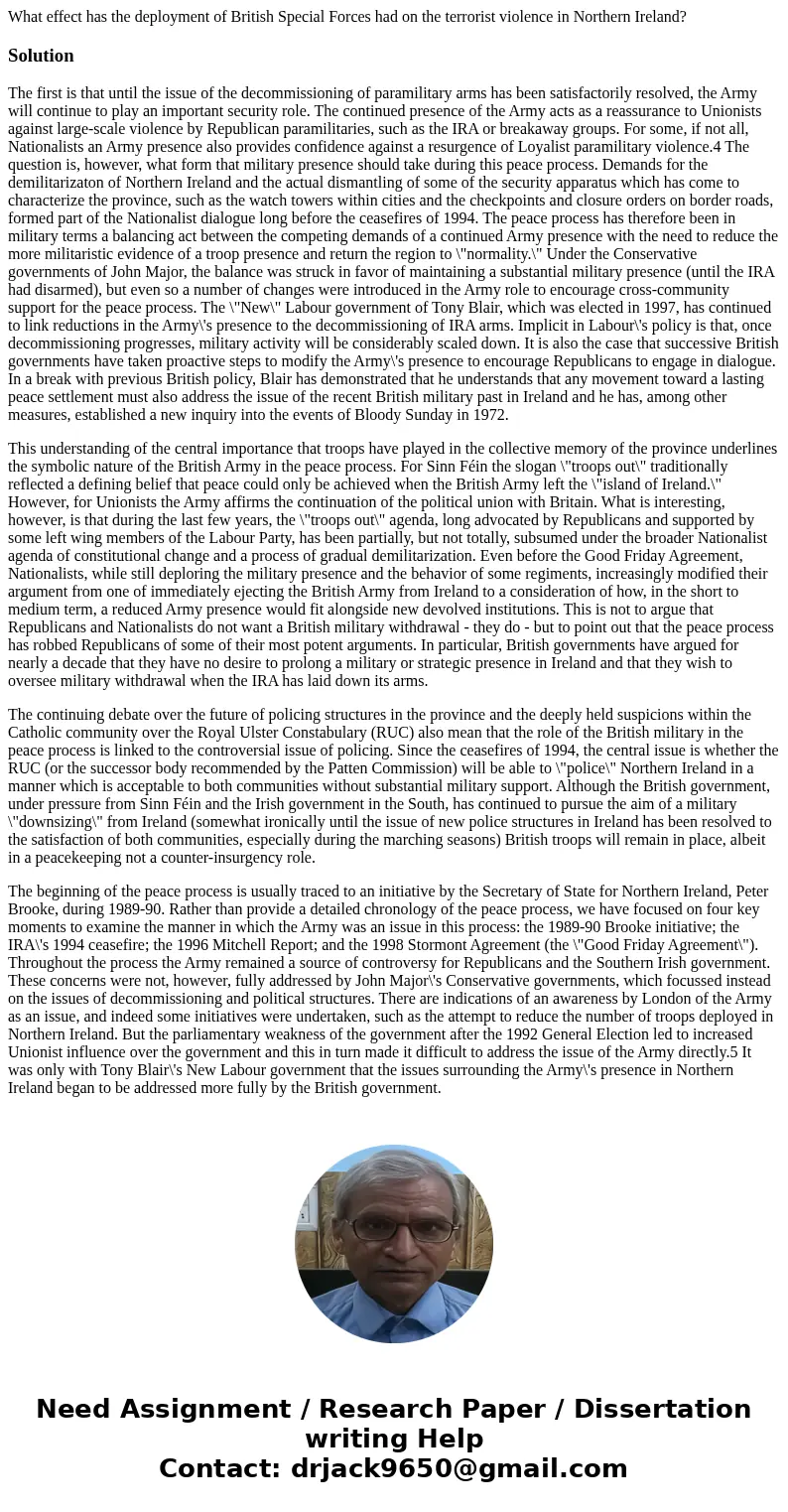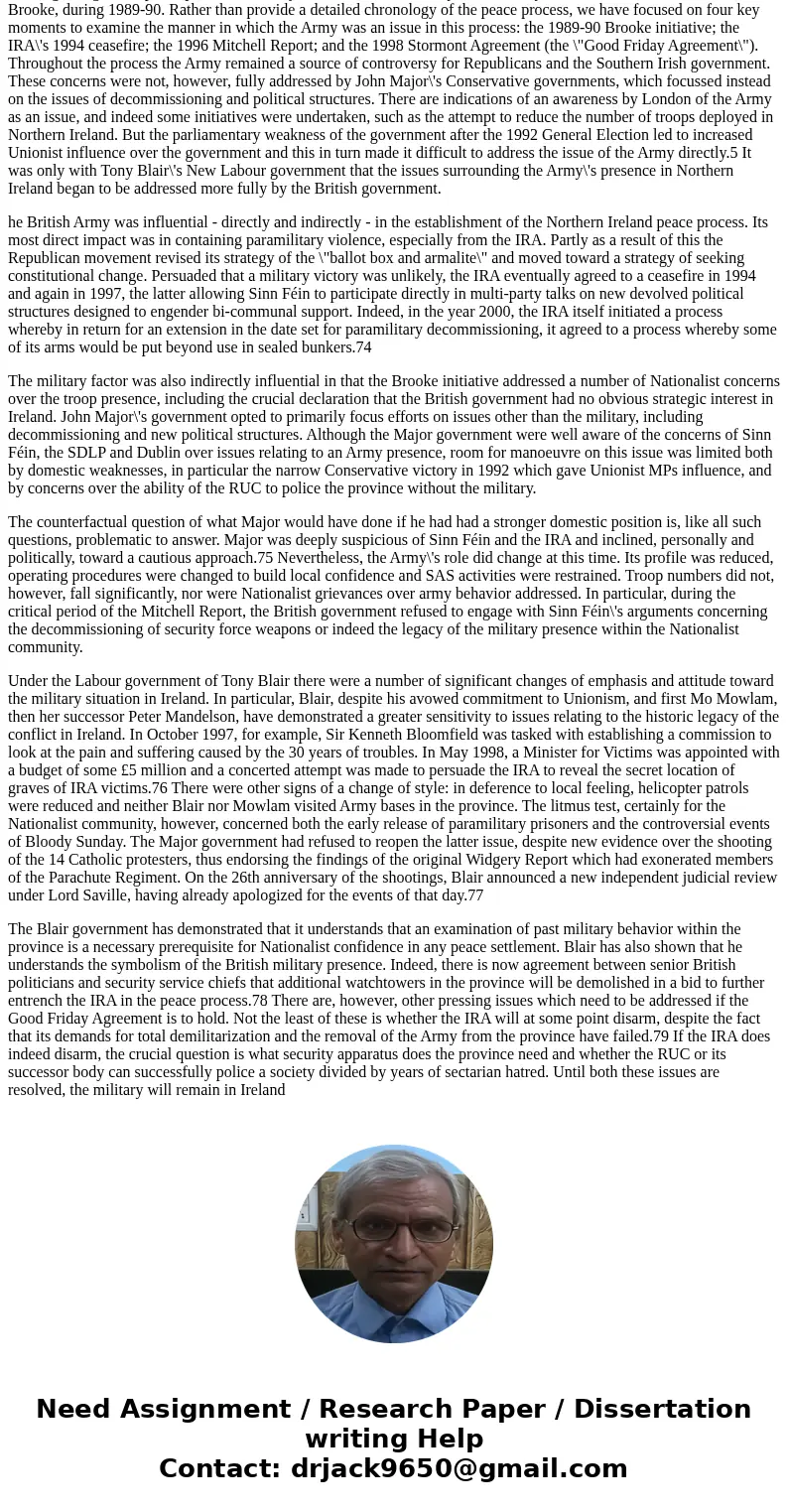What effect has the deployment of British Special Forces had
What effect has the deployment of British Special Forces had on the terrorist violence in Northern Ireland?
Solution
The first is that until the issue of the decommissioning of paramilitary arms has been satisfactorily resolved, the Army will continue to play an important security role. The continued presence of the Army acts as a reassurance to Unionists against large-scale violence by Republican paramilitaries, such as the IRA or breakaway groups. For some, if not all, Nationalists an Army presence also provides confidence against a resurgence of Loyalist paramilitary violence.4 The question is, however, what form that military presence should take during this peace process. Demands for the demilitarizaton of Northern Ireland and the actual dismantling of some of the security apparatus which has come to characterize the province, such as the watch towers within cities and the checkpoints and closure orders on border roads, formed part of the Nationalist dialogue long before the ceasefires of 1994. The peace process has therefore been in military terms a balancing act between the competing demands of a continued Army presence with the need to reduce the more militaristic evidence of a troop presence and return the region to \"normality.\" Under the Conservative governments of John Major, the balance was struck in favor of maintaining a substantial military presence (until the IRA had disarmed), but even so a number of changes were introduced in the Army role to encourage cross-community support for the peace process. The \"New\" Labour government of Tony Blair, which was elected in 1997, has continued to link reductions in the Army\'s presence to the decommissioning of IRA arms. Implicit in Labour\'s policy is that, once decommissioning progresses, military activity will be considerably scaled down. It is also the case that successive British governments have taken proactive steps to modify the Army\'s presence to encourage Republicans to engage in dialogue. In a break with previous British policy, Blair has demonstrated that he understands that any movement toward a lasting peace settlement must also address the issue of the recent British military past in Ireland and he has, among other measures, established a new inquiry into the events of Bloody Sunday in 1972.
This understanding of the central importance that troops have played in the collective memory of the province underlines the symbolic nature of the British Army in the peace process. For Sinn Féin the slogan \"troops out\" traditionally reflected a defining belief that peace could only be achieved when the British Army left the \"island of Ireland.\" However, for Unionists the Army affirms the continuation of the political union with Britain. What is interesting, however, is that during the last few years, the \"troops out\" agenda, long advocated by Republicans and supported by some left wing members of the Labour Party, has been partially, but not totally, subsumed under the broader Nationalist agenda of constitutional change and a process of gradual demilitarization. Even before the Good Friday Agreement, Nationalists, while still deploring the military presence and the behavior of some regiments, increasingly modified their argument from one of immediately ejecting the British Army from Ireland to a consideration of how, in the short to medium term, a reduced Army presence would fit alongside new devolved institutions. This is not to argue that Republicans and Nationalists do not want a British military withdrawal - they do - but to point out that the peace process has robbed Republicans of some of their most potent arguments. In particular, British governments have argued for nearly a decade that they have no desire to prolong a military or strategic presence in Ireland and that they wish to oversee military withdrawal when the IRA has laid down its arms.
The continuing debate over the future of policing structures in the province and the deeply held suspicions within the Catholic community over the Royal Ulster Constabulary (RUC) also mean that the role of the British military in the peace process is linked to the controversial issue of policing. Since the ceasefires of 1994, the central issue is whether the RUC (or the successor body recommended by the Patten Commission) will be able to \"police\" Northern Ireland in a manner which is acceptable to both communities without substantial military support. Although the British government, under pressure from Sinn Féin and the Irish government in the South, has continued to pursue the aim of a military \"downsizing\" from Ireland (somewhat ironically until the issue of new police structures in Ireland has been resolved to the satisfaction of both communities, especially during the marching seasons) British troops will remain in place, albeit in a peacekeeping not a counter-insurgency role.
The beginning of the peace process is usually traced to an initiative by the Secretary of State for Northern Ireland, Peter Brooke, during 1989-90. Rather than provide a detailed chronology of the peace process, we have focused on four key moments to examine the manner in which the Army was an issue in this process: the 1989-90 Brooke initiative; the IRA\'s 1994 ceasefire; the 1996 Mitchell Report; and the 1998 Stormont Agreement (the \"Good Friday Agreement\"). Throughout the process the Army remained a source of controversy for Republicans and the Southern Irish government. These concerns were not, however, fully addressed by John Major\'s Conservative governments, which focussed instead on the issues of decommissioning and political structures. There are indications of an awareness by London of the Army as an issue, and indeed some initiatives were undertaken, such as the attempt to reduce the number of troops deployed in Northern Ireland. But the parliamentary weakness of the government after the 1992 General Election led to increased Unionist influence over the government and this in turn made it difficult to address the issue of the Army directly.5 It was only with Tony Blair\'s New Labour government that the issues surrounding the Army\'s presence in Northern Ireland began to be addressed more fully by the British government.
he British Army was influential - directly and indirectly - in the establishment of the Northern Ireland peace process. Its most direct impact was in containing paramilitary violence, especially from the IRA. Partly as a result of this the Republican movement revised its strategy of the \"ballot box and armalite\" and moved toward a strategy of seeking constitutional change. Persuaded that a military victory was unlikely, the IRA eventually agreed to a ceasefire in 1994 and again in 1997, the latter allowing Sinn Féin to participate directly in multi-party talks on new devolved political structures designed to engender bi-communal support. Indeed, in the year 2000, the IRA itself initiated a process whereby in return for an extension in the date set for paramilitary decommissioning, it agreed to a process whereby some of its arms would be put beyond use in sealed bunkers.74
The military factor was also indirectly influential in that the Brooke initiative addressed a number of Nationalist concerns over the troop presence, including the crucial declaration that the British government had no obvious strategic interest in Ireland. John Major\'s government opted to primarily focus efforts on issues other than the military, including decommissioning and new political structures. Although the Major government were well aware of the concerns of Sinn Féin, the SDLP and Dublin over issues relating to an Army presence, room for manoeuvre on this issue was limited both by domestic weaknesses, in particular the narrow Conservative victory in 1992 which gave Unionist MPs influence, and by concerns over the ability of the RUC to police the province without the military.
The counterfactual question of what Major would have done if he had had a stronger domestic position is, like all such questions, problematic to answer. Major was deeply suspicious of Sinn Féin and the IRA and inclined, personally and politically, toward a cautious approach.75 Nevertheless, the Army\'s role did change at this time. Its profile was reduced, operating procedures were changed to build local confidence and SAS activities were restrained. Troop numbers did not, however, fall significantly, nor were Nationalist grievances over army behavior addressed. In particular, during the critical period of the Mitchell Report, the British government refused to engage with Sinn Féin\'s arguments concerning the decommissioning of security force weapons or indeed the legacy of the military presence within the Nationalist community.
Under the Labour government of Tony Blair there were a number of significant changes of emphasis and attitude toward the military situation in Ireland. In particular, Blair, despite his avowed commitment to Unionism, and first Mo Mowlam, then her successor Peter Mandelson, have demonstrated a greater sensitivity to issues relating to the historic legacy of the conflict in Ireland. In October 1997, for example, Sir Kenneth Bloomfield was tasked with establishing a commission to look at the pain and suffering caused by the 30 years of troubles. In May 1998, a Minister for Victims was appointed with a budget of some £5 million and a concerted attempt was made to persuade the IRA to reveal the secret location of graves of IRA victims.76 There were other signs of a change of style: in deference to local feeling, helicopter patrols were reduced and neither Blair nor Mowlam visited Army bases in the province. The litmus test, certainly for the Nationalist community, however, concerned both the early release of paramilitary prisoners and the controversial events of Bloody Sunday. The Major government had refused to reopen the latter issue, despite new evidence over the shooting of the 14 Catholic protesters, thus endorsing the findings of the original Widgery Report which had exonerated members of the Parachute Regiment. On the 26th anniversary of the shootings, Blair announced a new independent judicial review under Lord Saville, having already apologized for the events of that day.77
The Blair government has demonstrated that it understands that an examination of past military behavior within the province is a necessary prerequisite for Nationalist confidence in any peace settlement. Blair has also shown that he understands the symbolism of the British military presence. Indeed, there is now agreement between senior British politicians and security service chiefs that additional watchtowers in the province will be demolished in a bid to further entrench the IRA in the peace process.78 There are, however, other pressing issues which need to be addressed if the Good Friday Agreement is to hold. Not the least of these is whether the IRA will at some point disarm, despite the fact that its demands for total demilitarization and the removal of the Army from the province have failed.79 If the IRA does indeed disarm, the crucial question is what security apparatus does the province need and whether the RUC or its successor body can successfully police a society divided by years of sectarian hatred. Until both these issues are resolved, the military will remain in Ireland


 Homework Sourse
Homework Sourse